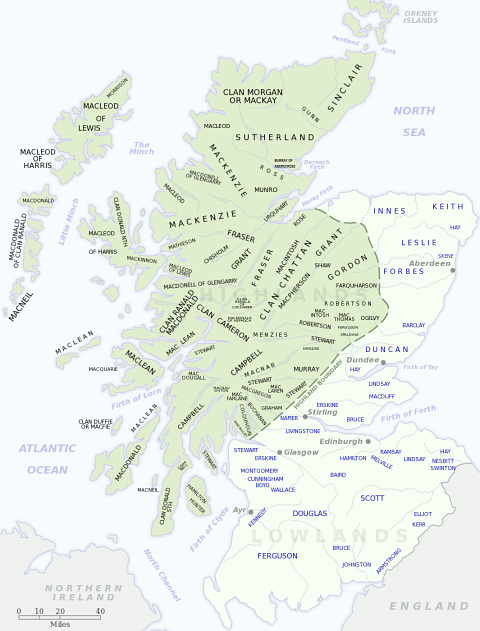
Motto: Dulcius ex asperis (Sweeter after difficulties)
Historic Seat: Kilkerran House
District: Ayrshire
Associated Surnames: Fergus, Ferries, MacAdie, MacFergus, MacKerras, MacKersey
Associated Tartans:
Early Ferguson Genealogy and History:
(Excerpt from "The Scottish Clans and Their Tartans", James Grant, 1906)
The name and clan of Fergusson have, singular to say, been more distinguished in times of peace than those of war and tumult, though many of the clan abode in Glenshee.
Among the earlier occurrences of the name, under David II, is a charter by Thomas, Earl of Mar, to Eugene Fergusson of the lands of Uchterterene, in Cromar; and in 1508, when John Fergusson of Stravith, with Sir William Scott of Balwearie and others, witnessed a bond of Manrent1.
At the Reformation, when a distribution of Preachers was made in 1560, David Fergusson was appointed to Dunfermline; and in 1582, with Erskine of Dun and others, he formed one of a deputation to James VI concerning the grievances of the Church. Four years previously there had been a complaint against him and others in a case of disputed jurisdiction between the Kirk and the civil power.
In 1587, Fergusson of Craigdarrock (or Craigdarnock), apparently the oldest line of the family, with Sir John Gordon of Lochinvar and others, was summoned before the Council for having been in rebellion against the King, and fined 3000 merks.
In 1649 "John Fergusson of Cragdare" (Craigdarroch) was Commissioner in Parliament for Dumfriesshire (Act Parl. Scot.).
Two of the clan, one known as "Robert the Plotter", and his brother, a General, came prominently forward in the early part of the 17th century. They were sons of the Laird of Badyfarrow, near Inverny. Robert went to London as an Independent minister, and took an active part in many conspiracies, among others, the famous Ryehouse Plot2; but he escaped detection once by hiding in the Tolbooth of Edinburgh, and he joined in every scheme against Charles II and James VII. At the Revolution he was rewarded for his rogueries by an appointment in the Excise; and being dissatisfied, he took to plotting against William III, and wrote against his Government with great effect, but always contrived to elude punishment. Among his publications were a Vindication of the Colony at Darien3, A History of the Revolution, etc. He died in 1714.
His brother James Fergusson, a Major-General of 1705, served with distinction under Marlborough, and is mentioned with honour in the Blenheim Despatches. He led the attack on the village. His descendants still possess lands at Kimmundy, in Aberdeenshire. Another of the name, William Fergusson, was an eminent painter in still life. He travelled in Italy and France, and died in 1690.
Sir John Fergusson of Kilkerran held extensive estates in Ayrshire in the time of Charles I. His son John was made a Baronet in 1703, according to Burke, and his grandson was Lord Kilkerran. Sir Adam, third Baronet, claimed the Earldom of Glencairn, but failed to make good his title. The Fergussons, Baronets of Farm, Tyrone, went there from Scotland 280 years ago.
James Fergusson, the eminent self-taught philosopher, born in 1710, Adam Fergusson, LL.D4, the great historian and moral philosopher, born in 1724; Robert Fergusson, the unfortunate poet, born in 1750; James Fergusson, the architect, born in 1808; and Sir William Fergusson, Bart., F.R.S.5, born in the same year, have all cast a lustre on this clan and surname.
"Annie Laurie" of Maxwellton, so famed in Scottish song, became the wife of Fergusson of Craigdarroch; and their descendant, Robert Cutlar Fergusson, the accomplished scholar, figures in Burns' well-known poem, "The Whistle."
Brigadier General Fergusson bore a distinguished part at the capture of the Cape of Good Hope; he commanded the Highland Brigade, consisting of the 71st, 72nd, and 93rd Regiments, and led the charge which put the enemy to flight.
Sir Adam Fergusson, third Baronet, died in 1813, and was succeeded by his nephew James, fourth Baronet, who died in 1838. He was succeeded by his son Charles, fifth Baronet, who died in 1849, leaving the Right Honourable Sir James Fergusson, sixth Baronet, G.C.S.I.6, K.C.M.G.7, etc.
(End excerpt)
Next page: Clan Forbes
Footnotes:
1 Manrent: A Scottish contract of the mid-15th century to the early 17th century, usually military in nature and involving Scottish clans. The bond of manrent was commonly an instrument in which a weaker man or clan pledged to serve, in return for protection, a stronger lord or clan. Essentially, it was a promise by one person to serve another, such that he shall be friend to all his friends, and foe to all his foes. Read more about Manrents at Wikipedia.
2 Ryehouse Plot: A plan to assassinate King Charles II of England and his brother (and heir to the throne) James, Duke of York. Read more about the Ryehouse Plot, and the people involved, at Wikipedia.
3 The Colony at Darien: The Darien scheme was an unsuccessful attempt by the Kingdom of Scotland to become a world trading state by establishing a colony called "Caledonia" on the on the Gulf of Darién, Panama, in the late 1690s. Read more about the Darien Scheme at Wikipedia.
4 LL. D: Doctor of Law
5 F.R.S.: Fellow of the Royal Society. Read about Fellowship of the Royal Society at Wikipedia.
6 G.C.S.I.: Knight Grand Commander, The Most Exalted Order of the Star of India. Read about the Order of the Star of India at Wikipedia.
7 K.C.M.G.: Knight Commander, The Most Distinguished Order of St Michael and St George. Read about the Order of St Michael and St George at Wikipedia.

Distribution of Scottish clans and families
View larger map at Wikimedia Commons

Browse the Clan Ferguson Tartan Collection with home decor, personal accessories, crafting, paper products, and more.

Browse the Ayrshire Scotland District Tartan Collection with home decor, personal accessories, crafting, paper products, and more.

Clan Ferguson Postcard: Digitally cleaned and enhanced vintage illustration with tartan border.